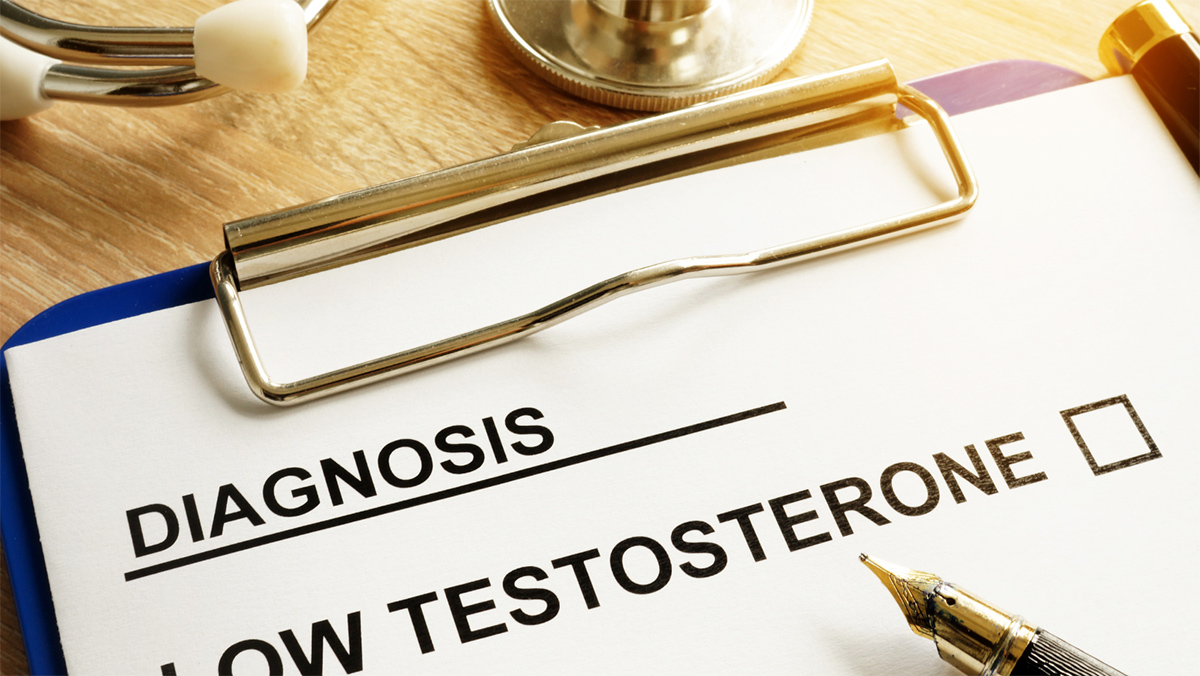Low Testosterone
While testosterone levels are generally expected to decline with age (1% decrease each year after 30), notably low levels characteristic of hypogonadism are seen in an estimated 35% of men aged 45 and above.2 For adult men, low testosterone is defined as less than 300 ng/dL of blood.3
Causes
Low testosterone is divided into two major categories — primary and secondary hypogonadism — and these conditions have separate causes. Primary hypogonadism, or primary testicular failure, decreases testosterone levels at the source of production.4 Impaired testicular function can be caused by:4
- Injury (physical trauma, infection, cancer, chemotherapy, radiation)
- Genetic abnormalities
- Undescended testicles left untreated past childhood
Secondary hypogonadism encompasses disorders of the pituitary gland or hypothalamus that impact endocrine and/or nervous system communication regarding testosterone production.4 These causes include:4
- Pituitary disorders or tumors
- Chronic diseases (obesity, type 2 diabetes, HIV/AIDS, liver or kidney disease)
- Certain medications (opioids or corticosteroids)
- Anabolic steroids
Symptoms
The most common symptoms of low testosterone are:2,5
- Erectile dysfunction
- Increased risk of Benign prostatic hyperplasia (BPH)
- Decreased libido
- Lowered sperm count
- Testicular atrophy
- Reduced bone and muscle mass
- Breast enlargement
- Hair loss
- Fatigue
- Depression
Treatment
The primary treatment for male hypogonadism is testosterone replacement therapy. However, if low testosterone is the result of an underlying health complication, that condition may need to be resolved first. Hormone replacement therapy takes multiple forms, such as weekly injections, topical gels, patches, buccal tablets, subdermal pellets, and nasal gels.2
High Testosterone
Abnormally high testosterone levels, or male hypergonadism, are less common than low testosterone but may still pose a threat to urological health. Testosterone levels are considered to be high if blood concentration exceeds 950 ng/dL.6
Causes
High testosterone can be caused by a number of physical disorders, but men using anabolic steroids are at an especially high risk of developing a testosterone imbalance.7 Common causes of high testosterone include:8
- Testicular tumors
- Liver or kidney disease
- Autoimmune diseases (Addison’s or Hashimoto’s thyroiditis)
- Injury to certain glands (pituitary, genital, adrenal, endocrine, pineal)
Symptoms
While hypergonadism and hypogonadism share multiple symptoms, high testosterone is often linked to more serious health complications. The most prevalent symptoms of hypergonadism are:8
- Erectile dysfunction
- BPH
- Reduced sperm count
- Testicular atrophy
- Damage to heart muscles
- Liver disease
- Hypertension
- High cholesterol
- Increased risk of blood clots
- Edemia
- Weight gain
- Acne
- Mood swings
- Aggression
Treatments
Treating hypergonadism is a time-intensive and complex process, as reducing testosterone levels may lead to other problematic side effects. Unlike testosterone replacement therapy, testosterone-reducing medications require tailor-made treatment plans calibrated to each patient’s natural hormone levels.9 The most effective medical therapy regimens differ widely based on the underlying causes, comorbid conditions, and the patient’s overall health.
Clinical Significance
Despite opposite pathological mechanisms, erectile dysfunction (ED) and benign prostatic hyperplasia (BPH) can be caused by both low and high testosterone levels. Although not the only symptoms linked to these conditions, ED and BPH are challenging complications to live with day in and day out. Sexual dysfunction disrupts an integral part of a healthy lifestyle, and prostate enlargement often impacts urinary function and causes considerable discomfort. Successful treatment for both hypogonadism and hypergonadism might not only include bringing testosterone levels back to the normal range, but also resolving the associated symptoms that significantly impact quality of life.
Sources
-
- Graf, A. (2019). 24 hours in the life of a hormone: what time is the right time for a pituitary function test? The Endocrinologist, Winter 2019(134), 16-17.
- Hypogonadism in Men. (January 24, 2022). Endocrine Society. https://www.endocrine.org/patient-engagement/endocrine-library/hypogonadism
- Low Testosterone (Male Hypogonadism). (n.d.). Cleveland Clinic. https://my.clevelandclinic.org/health/diseases/15603-low-testosterone-male-hypogonadism
- Doheny, K. & Sargis, R.M. (October 20, 2022). Low Testosterone Symptoms, Causes, and Treatment. EndocrineWeb. https://www.endocrineweb.com/conditions/low-testosterone
- Xia, B.W., Zhao, S.C., Chen, Z.P., Chen, C., Liu, T.S., Yang, F., Yan, Y. (2021). Relationship between serum total testosterone and prostate volume in aging men. Scientific Reports 11(14122).
- Gurevich, R. (April 20, 2020). Understanding High and Low Testosterone Levels in Men and Women. Verywell Family. https://www.verywellfamily.com/high-and-low-testosterone-levels-in-men-and-women-1959949#:~:text=Abnormally%20high%20testosterone%20levels%20are,is%20above%2030%20ng%2FdL
- Testosterone — What It Does And Doesn’t Do. (August 29, 2019). Harvard Health Publishing. https://www.health.harvard.edu/medications/testosterone–what-it-does-and-doesnt-do
- Biggers, A. (June 25, 2018). What is Hypergonadism? Healthline. https://www.healthline.com/health/hypergonadism
- An Overview of Hypergonadism. (n.d.). Complete Care Community Health Center. https://ccchclinic.com/an-overview-of-hypergonadism/

